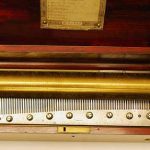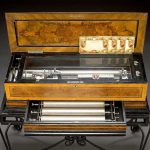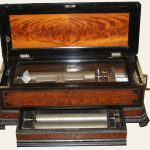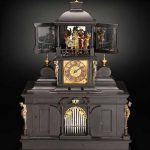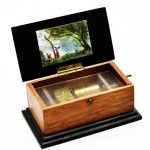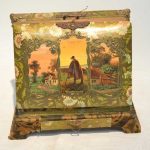Ebony has a long history of use, with carved pieces having been found in Ancient Egyptian tombs.
By the end of the 16th century, fine cabinets for the luxury trade were made of ebony in Antwerp. The wood’s dense hardness lent itself to refined moldings framing finely detailed pictorial panels with carving in very low relief (bas-relief), usually of allegorical subjects, or with scenes taken from classical or Christian history. Within a short time, such cabinets were also being made in Paris, where their makers became known as ébénistes, which remains the French term for a cabinetmaker.
Cylinder music box playing eight tunes with a keywind mechanism. Case of mahogany with ebony stringing.
Reference: © Victoria and Albert Museum
A Swiss interchangeable cylinder music box last quarter 19th century The ratchet wound movement numbered 21189 playing six tunes on each of the four 17 1/2-inch interchangeable cylinders, with four tune sheets, contained in a crossbanded burled walnut and ebony case, raised on a later wrought iron stand. height of case 12in (31cm); width 43in (1.09m); depth 17in (43cm)
Sold for US$ 5,700 (£ 4,548) inc. premium at Bonham’s in 2007
A LOUIS XV ORMOLU AND EBONY MUSICAL CLOCK ‘L’ALLÉGORIE DE LA BATAILLE DE FONTENOY’ OR ‘LA PAIX’ THE CASE ATTRIBUTED TO JEAN-JOSEPH DE SAINT GERMAIN, THE MUSICAL MOVEMENT BY PIERRE-ANTOINE REGNAULT, THE PLINTH ATTRIBUTED TO PHILIPPE-CLAUDE MONTIGNY, CIRCA 1765 The case surmounted by a flowering urn and flanked by a figure of Minerva and opposed by two putti, one with an open book inscribed ‘BATAILLE DE FONTENOY/ TRAITES DE PAIX’, the other holding a floor plan of a fortress, raised on a rectangular plinth above an ebony base with pierced entrelac frieze, flanked by panoply, the glass dial with Roman hours and Arabic five minutes, with concentric date ring, the hands and bezel applied with paste gems, the skeletonised twin barrel movement with profusely engraved plates and barrels, with later Brocot suspension, the musical movement with gut fusee, thirteen bells, twenty four hammers and playing twelve tunes, the movement signed ‘Regnault à Paris’, the interior of plinth numbered in pencil ‘R 1174’, further inscribed with a 19th Century repairer’s signature ‘Braconot / XIII – 53 a Paris’ 29 ¾ in. (75.5 cm.) high; 24 ½ in. (62.5 cm.) wide; 10 ¼ in. (26 cm.) deep
Sold for GBP 212,500 at Christie’s in 2019
19th c. Jacot & Son Swiss 14.75″ interchangeable cylinder music box in flame mahogany veneered and inlaid ebony case, lower concealed drawer revealing two additional tune cylinders, having original “Jacot and Son 39 Union Square New York” celluloid dealer’s tag 11.5″ x 32″ x 14.5″ – 4 feet loose
Sold for $1,700 at Duane Merrill & Company in 2019
Musical Clock with Musical Clock and Organ,ca. 1625 Veit Langenbucher German
Inside the ebony case of this musical clock is an extremely rare and important instrument consisting of a sixteen-note pipe organ and a sixteen-string spinet that may be played independently of the organ. Made by the renowned team of Samuel Bidermann and his son (also Samuel)–the father’s L-shaped pinning style appears in this work–and Viet Langenbucher, the extraordinary piece includes, in addition to the organ and spinet, a clock and five carved and colorfully clad commedia dell’arte figures that perform a circling dance in the clock’s tower when the instruments sound to mark the hours.
The complex clock is perhaps the most musically elaborate automatic instrument to survive from the early seventeenth century. Its three airs, probably by composer Hans Leo Hassler (baptized 1564-1612), the elder Bidermann’s teacher and once keeper of the knowledge of pinning barrels in Augsburg, are stored on the original pinned cylinder. Most cylinders and their tunes were replaced by subsequent generations, but this one was spared to provide us with an extremely rare musical document that allows us to hear the airs as they were played in the seventeenth century.
Reference: The Metropolitan Museum of Art
Lew Kummerow working dollhouse music box with a working Swiss wind-up movement, mahogany body with ebony lid and base, hand painted landscape under lid and glass cover over Reuge movement, 2″W excluding handle
Sold for $475 at Ron Rhoads Auctioneers in 2019
